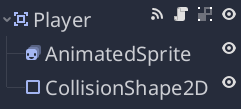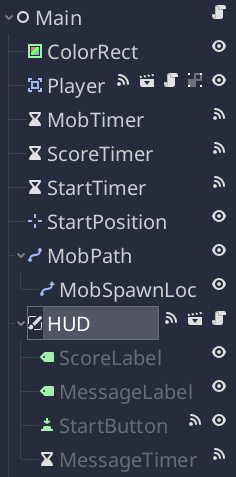Understanding node paths
Problem
It’s probably the most common problem seen in the Godot help channels: an invalid node reference. Most often, it appears as the following error message:
Invalid get index ‘position’ (on base: ’null instance’).
Solution
It’s that last part, the “null instance”, that’s the source of this problem, and the main source of confusion for Godot beginners.
The way to avoid this problem is to understand the concept of node paths.
Understanding node paths
The scene tree is made of nodes, which are connected together in parent-child relationships. A node path is the path it takes to get from one node to another by moving through this tree.
As an example, let’s take a simple “Player” scene:
The script for this scene is on the Player node. If the script needs to call play() on the AnimatedSprite node, it needs a reference to that node:
get_node("AnimatedSprite").play()
The argument of the get_node() function is a string representing the path to the desired node. In this case, it’s a child of the node the script is on. If the path you give it is invalid, you’ll get the dreaded null instance error (as well as “Node not found”).
Getting a node reference with get_node() is such a common situation that GDScript has a shortcut for it:
$AnimatedSprite.play()
get_node() returns a reference to the desired node.
Let’s look at a more complex scene tree:
If the script on Main needs to access ScoreLabel it can do so with this path:
get_node("HUD/ScoreLabel").text = "0"
# or using the shortcut:
$HUD/ScoreLabel.text = "0"
When using $ notation, the Godot editor will autocomplete paths for you. You can also right-click on a node in the Scene tab and choose “Copy Node Path”.
What if the node you want to access is higher in the tree? You can use get_parent() or ".." to reference the parent node. In the above example tree, to get the Player node from the ScoreLabel:
get_node("../../Player")
Let’s break that down. The path "../../Player" means “get the node that’s up one level (HUD), then one more level (Main), then its child Player”.
Does this seem familiar? Node paths work exactly like directory paths in your operating system. The / character indicates the parent-child relationship, and .. means “up one level”.
Relative vs absolute paths
The above examples all use relative paths - meaning they start at the current node and follow the path to the destination. Node paths can also be absolute, starting from the root node of the scene.
For example, the absolute path to the player node is:
get_node("/root/Main/Player")
/root, which can also be accessed with get_tree().root is not the root node of your scene. It’s the Viewport node that is always present by default in the SceneTree.
A warning
While the above examples work just fine, there are some things you should be aware of that may cause problems later. Imagine the following situation: the Player node has a health property, which you want to display in a HealthBar node somewhere in your UI. You might write something like this in the player’s script:
func take_damage(amount):
health -= amount
get_node("../Main/UI/HealthBar").text = str(health)
While this may work fine at first, it is brittle, meaning it can break easily. There are two main problems with this kind of arrangement:
- You can’t test the player scene independently. If you run the player scene by itself or in a test scene that doesn’t have a UI, the
get_node()line will cause a crash. - You can’t change your UI. If you decide to rearrange or redesign your UI, the path will no longer be valid and you have to change it.
For this reason, you should try to avoid using node paths that go up the scene tree. In the above situation, if the player instead emitted a signal when the health changed, the UI could listen for that signal to update itself. You could then rearrange and separate nodes without fear of breaking your game.
Wrapping up
Once you understand how to use node paths, you’ll see how easy it is to reference any node you need. And put a stop to seeing those null instance error messages.

